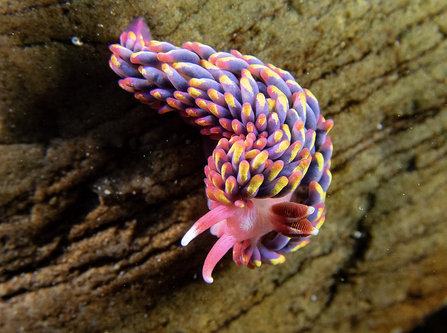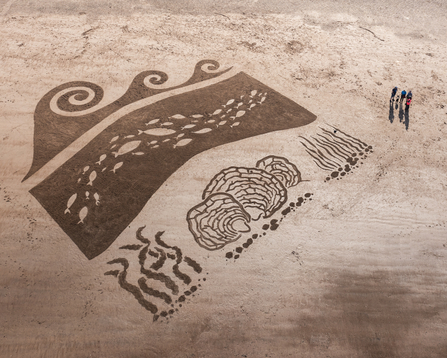
Rainbow sea slug © Paul Naylor

Rainbow sea slug © Paul Naylor
Seaside volunteers throughout the UK clocked over 46,000 thousand hours surveying shorelines and recording wildlife. Discoveries include climate-indicator sea slugs and seaweeds, plus sightings of conger eels and humpback whales.
Ground breaking research, pioneering nature recovery projects and a complete network of snorkel trails around Scotland also feature in the annual marine round-up.
The Wildlife Trusts, and 80% of the British public, want to see bottom trawling banned in protected areas, and measures to ensure that offshore developments are nature positive. The charities say that strengthening protection of the UK’s blue carbon can help to achieve climate and biodiversity goals.
In this region, Northumberland Wildlife Trust launched the Blue Influencer Scheme to empower young people to address nature and climate issues affecting local waters by designing and delivering their own youth-led projects.

Beach mural at Hauxley © Northumberland Wildlife Trust
In addition, The Stronger Shores project has spent the year working to make the region’s coastlines and communities stronger in the face of flooding, coastal erosion and climate change by conducting seagrass surveys in the mouths of the rivers Coquet, Don, Aln, Blyth and Wansbeck, as well as hosting National Marine celebrations with the wildlife charity’s Wild City team and sand artist Soul2Sand.
Duncan Hutt, Northumberland Wildlife Trust Director of Conservation says:
“People are central to nature recovery and made huge contributions to our knowledge of UK seas this year. Wildlife surveys and monitoring have led to incredible discoveries, including new species on UK shores. Success stories demonstrate the enormous value of marine conservation and why robust protection is critical for nature recovery.”
“As the first country to map all its blue carbon habitats, the UK has a unique position to champion better protection for seabed habitats. They are the unsung heroes in our fight against climate change. We need policies that stop damaging activities in protected areas, plus continued support for innovation, monitoring, and work to improve coastal habitats.”
Discoveries of climate change indicators and non-native species were made throughout The Wildlife Trusts’ national intertidal survey programme, Shoresearch, and volunteering days. It was also one of the charities behind The Blue Carbon Mapping Project, which saw the UK become the first country to estimate the carbon stored in its seabed habitats. The subsequent report reinforced calls to ban bottom-trawling in Marine Protected Areas (MPAs), as 43% of the UK’s blue carbon is in these zones.
Read the full Wildlife Trusts' Marine Review here.